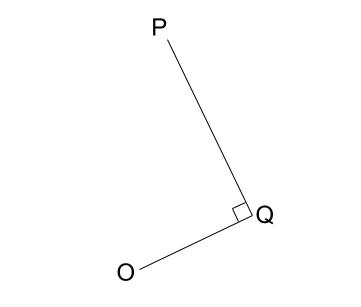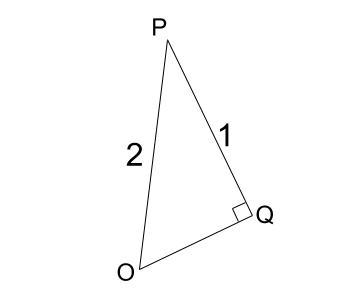【センター試験Ⅱ・B】三角関数と座標平面の融合
センター試験・過去問研究
センター試験の過去問を徹底解説します。
センター試験とはどれくらいのレベルの問題が出るのか、どのような出題があるのか、まずは経験値をつみましょう!
\(O\) を原点とする座標平面上の \(2\) 点 \(P(2 \cos \theta ,2\sin \theta) \)、\(Q(2 \cos \theta +\cos 7\theta, 2 \sin \theta +\sin 7\theta)\) を考える。
ただし、\(\displaystyle \frac{\pi}{8} \leqq \theta \leqq \displaystyle \frac{\pi}{4}\) とする。
(1)\(OP=ア,PQ=イ\) である。また、
\(OQ^2=ウ+エ(\cos 7\theta \cos \theta+ \sin 7\theta \sin \theta)\)
\(=ウ+エ\cos (オ\theta)\)
である。
筆者注 続く
解説
座標が三角関数ですね。あまり見慣れない問題かもしれませんが、センター試験では良くある問題です。
ビビらないで普通に処理していきましょう!
\(OP=ア,PQ=イ\) ですが、ただの計算問題ですね。
\(OP=\sqrt{(2 \cos \theta)^2+(2\sin \theta)^2}=2\)
より、ア=2
\(PQ=\sqrt{\{(2 \cos \theta +\cos 7\theta)-2 \cos \theta\}^2+\{ (2 \sin \theta +\sin 7\theta)-2\sin \theta\}^2}\)
\(=\sqrt{\cos^2 7\theta+\sin^2 7\theta}\)
\(=1\)
より、イ=1
\(OQ^2\) もとにかく計算してみましょう。
\(OQ^2\)\(=(2 \cos \theta +\cos 7\theta)^2+( 2 \sin \theta +\sin 7\theta)^2\)
\(=4\cos^2 \theta+4\cos \theta \cos 7\theta+\cos^2 7\theta\)
\(+4\sin^2 \theta+4\sin \theta \sin 7\theta+\sin^2 7\theta\)
\(=4(\cos^2\theta+\sin^2\theta)+(\cos^2 7\theta+\sin^2 7\theta)\)
\(+4\cos \theta \cos 7\theta+4\sin \theta \sin 7\theta\)
\(=5+4(\cos \theta \cos 7\theta+\sin \theta \sin 7\theta)\)
ここまでは一直線ですね。
より、ウ=5、エ=4
次は、
\(5+4(\cos \theta \cos 7\theta+\sin \theta \sin 7\theta)\)\(=5+4\cos (オ\theta)\)
という変形を求められています。
※右辺は、ウ=5、エ=4を代入したもの
これは明らかに加法定理です。
\(\cos (オ\theta)=\cos \theta \cos 7\theta+\sin \theta \sin 7\theta\) です。
\(オ\theta=a\theta-b\theta\) とすれば、
\(\cos (a\theta-b\theta)=\cos a\theta \cos b\theta+\sin a\theta \sin b\theta\)
なので、
\(a=7,b=1\) が成り立ちます。
よって、\(オ=a-b=6\)
オ=6
\(OQ\) は、\(\theta=\displaystyle \frac{\pi}{カ}\) のとき最大値 \(\sqrt{キ}\) をとる。
筆者注 (2)へ続く
当然ですが、
\(OQ^2=5+4\cos(6\theta)\)
がカギを握っています。
\(OQ\) は正なので、\(OQ\) が最大値のときに \(OQ^2\) が最大値をとり、かつ、\(OQ^2\) が最大値のときに \(OQ\) が最大値をとります。
よって、\(OQ^2=5+4\cos(6\theta)\) が最大値をとる \(\theta\) を求めます。
\(\displaystyle \frac{\pi}{8} \leqq \theta \leqq \displaystyle \frac{\pi}{4}\) の範囲なので、
\(6\) 倍して、
\(\displaystyle \frac{3}{4}\pi \leqq 6\theta \leqq \displaystyle \frac{3}{2}\pi\)
この範囲で \(\cos 6\theta\) は
\(-1 \leqq \cos 6\theta \leqq 0\) です。
よって、\(\cos 6\theta =0\) のときに、
\(OQ^2=5+4\cos(6\theta)=5\) という最大値をとります。
このとき、\( 6\theta =\displaystyle \frac{3}{2}\pi\) より、\( \theta =\displaystyle \frac{\pi}{4}\)
よりカ=4
また、\(OQ^2=5+4\cos(6\theta)=5\) より、\(OQ \gt 0\) なので、\(OQ=\sqrt{5}\)
よりキ=5
では後半戦です。
\(3\) 点 \(O,P,Q\) が一直線上にあるような \( \theta\) の値を求めよう。
直線 \(OP\) を表す方程式は \(ク\) である。\(ク\) に当てはまるものを、次の0から3のうちから一つ選べ。
0 \((\cos \theta)x+(\sin \theta)y=0\)
1 \((\sin \theta)x+(\cos \theta)y=0\)
2 \((\cos \theta)x-(\sin \theta)y=0\)
3 \((\sin \theta)x-(\cos \theta)y=0\)
筆者注 続く
原点 \(O\) と\(P(2 \cos \theta ,2\sin \theta) \) を通る直線の方程式です。
中学生レベルの知識で解けばOKです。
直線の傾きは、\(\displaystyle \frac{2 \sin \theta}{2 \cos \theta}=\displaystyle \frac{\sin \theta}{\cos \theta}\)
※ \(\tan \theta\) ですけど、次の式変形があるので。
より、求める直線の方程式は、
\(y-2\sin \theta=\displaystyle \frac{\sin \theta}{\cos \theta}(x-2 \cos \theta)\)
整理すると、
選択肢3の\((\sin \theta)x-(\cos \theta)y=0\)
となります。
ク=3
\(\theta=\displaystyle \frac{\pi}{ケ}\) のときであることがわかる。
筆者注 続く
「このこと」とは直前に求めた直線 \(OP\) の方程式です。
つまり、点 \(Q\) が直線 \(OP\) 上にあれば良い、という条件から求められます。
\(Q(2 \cos \theta +\cos 7\theta, 2 \sin \theta +\sin 7\theta)\) を、\((\sin \theta)x-(\cos \theta)y=0\) に代入します。
\((\sin \theta)(2 \cos \theta +\cos 7\theta)\)\(-(\cos \theta)(2 \sin \theta +\sin 7\theta)=0\)
とにかく何か活路が見えるはずと信じて、計算を進めていきます。
\((2\sin \theta \cos \theta +\sin \theta\cos 7\theta)\)\(-(2 \sin \theta\cos \theta +\sin 7\theta\cos \theta)=0\)
これは・・・加法定理のときにでてくる項に似ていますから・・・
加法定理になるように変形します。
\((2\sin \theta \cos \theta -2 \sin \theta\cos\theta)\)\(+(\sin \theta\cos 7\theta-\sin 7\theta\cos \theta)=0\)
\(\sin \theta\cos 7\theta-\sin 7\theta\cos \theta=0\)
これは間違いなく加法定理ですね。
\(\sin(\alpha+\beta)=\sin \theta\cos 7\theta-\sin 7\theta\cos \theta\)
のはずですから、
\(\alpha= \theta\)
\(\beta=-7 \theta\)
でうまくいきます。
よって、\(\sin \theta\cos 7\theta-\sin 7\theta\cos \theta=0\) は、
\(\sin(\theta-7 \theta)=0\) と変形されます。
もちろん、\(\sin(-6\theta)=0\) です。
\(\displaystyle \frac{\pi}{8} \leqq \theta \leqq \displaystyle \frac{\pi}{4}\) の範囲でこれが成り立つのは、
\(\theta=\displaystyle \frac{\pi}{6}\)
より、ケ=6
さて、最後です。
\(\angle OQP\) が直角となるのは \(OQ=\sqrt{コ}\) のときである。したがって、\(\displaystyle \frac{\pi}{8} \leqq \theta \leqq \displaystyle \frac{\pi}{4}\) の範囲で、\(\angle OQP\) が直角となるのは
\(\theta=\displaystyle \frac{サ}{シ}\pi\) のときである。
筆者注 以上
まず大事なことですが、(2)とは無関係な問題です。
(2)を長々と解いた後(3)ですから、(2)(3)が続きものであると勘違いが起きる可能性があります。
しかし。
(2)は\(3\) 点 \(O,P,Q\) が一直線上にあるような \( \theta\) の値を求めよう。
でした。
(3)は、\(\angle OQP\) が直角となるときです。
全く別のケースを考える問題です。(2)に引きづられないようにしましょう。
さて、解いていきましょう。
で・・・
何を使って解いたら良いのか・・・迷子・・・
こんな人、多そうです。
結論を言えば、
(1)を使うのです!
(1)と(3)は無関係ではありませんからね。
で、(1)を使うというヒントを読んで、自分で考えて解いてみてくださいね。
自力で解けましたか?
次も以外に盲点で、先に進めなくなってしまう人が多発しそうですが・・・
ずばり図示をしましょう!
基本ですね。
問題を解くために大事なことは情報整理です。
そして、情報整理の筆頭が図示ですね。
正確な情報はわかりませんが、図示をしてみるクセをつけましょう。
\(\angle OQP\) が直角とは、下図のようなとき

で、(1)でわかっていることって・・・
\(OP=2,PQ=1\) ですね。
あ!三平方の定理じゃないですか・・・

図の長さがおかしいですか、こんなこと、問題を解くときはよくあることです。
\(OQ^2=2^2-1^2=3\)
\(OQ\) は正なので、\(OQ=\sqrt{3}\)
より、コ=3
※正しい図は、正三角形の半分、三角定規型でした。
(1)では、
\(OQ^2=5+4\cos(6\theta)\)
であることも求めました。
\(OQ=\sqrt{3}\) のとき
\(3=5+4\cos(6\theta)\)
\(\cos(6\theta)=-\displaystyle \frac{1}{2}\)
\(\displaystyle \frac{\pi}{8} \leqq \theta \leqq \displaystyle \frac{\pi}{4}\) の範囲で、これを満たすのは、
\(\theta=\displaystyle \frac{2}{9}\pi \)
より、サ=2、シ=9
以上、求まりました!